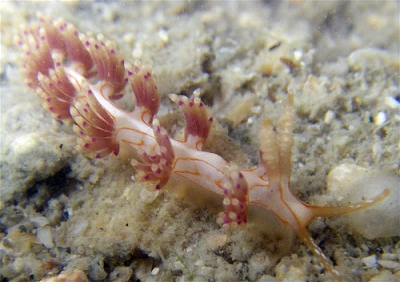
Flabellina sp. 9
Order: NUDIBRANCHIA
Suborder: AEOLIDINA
Family: Flabellinidae
PHOTO
Locality: Big Sisters Island, 0m, Singapore, South China Sea, 08 February 2008, Intertidal . Length: 15 mm. Photographer: Toh Chay Hoon.
Colour pattern very distinctive. From body shape it is most probably a species of Flabellina.
Authorship detailsRudman, W.B., 2008 (October 31) Flabellina sp. 9 [In] Sea Slug Forum. Australian Museum, Sydney. Available from http://www.seaslugforum.net/find/flabsp9
Related messages
Flabellina sp. 9 from the Andaman Sea
November 6, 2009
From: Lawrence Neal
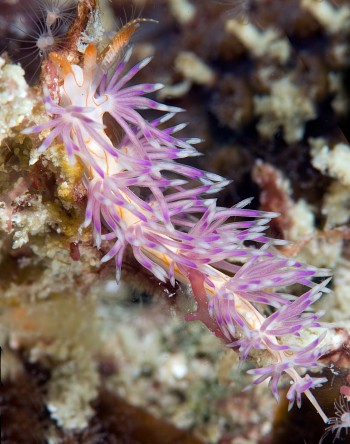
Dear Bill,
Here are some shots of an aeolid from the Andaman Sea, East Indian Ocean. The white body with orange lines, orange oral tentacles with white flecks and the rhinophores seem indicative of Flabellina sp. 9. This specimen had 8 pairs of cerata clusters. I believe it was feeding on the hydroids visible in the pictures, which were growing on a sand slope at around 16 metres depth.
Locality: Lek Island (Koh Lek), Adang-Rawi Archipelago, 16 metres, Satun province, Thailand, Indian Ocean, Andaman Sea, 24 October 2009, Sand slope. Length: 25 mm. Photographer: Lawrence Neal.
I noticed in another website this species has been identified as Facelina sp. (presumably an educated guess too). Is there any reliable way to identify these aeolid genera apart using external features?
Thanks and all the best,
Lawrence
lorenzo_n@yahoo.com
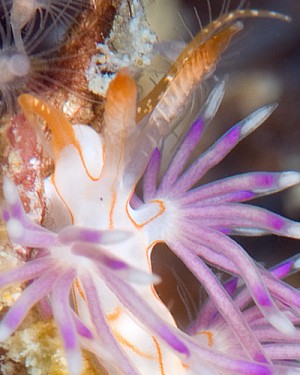
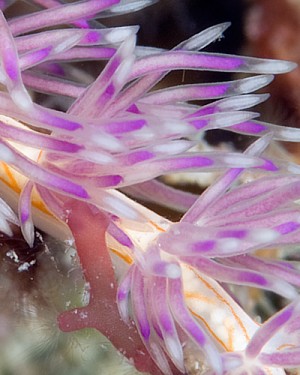
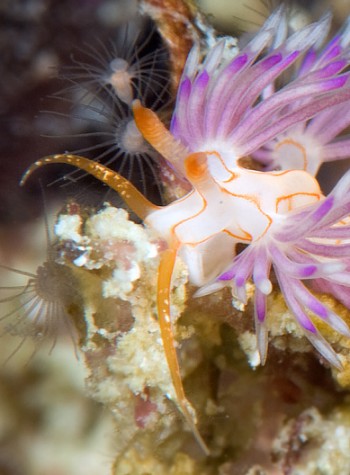
Dear Lawrence,
Thanks for these photos, which give us such a good view of the colour pattern and the external anatomy. As to identifying species to genera from external features, I am afraid most rules of thumb are broken in most genera, and definitely all families, of the aeolids.
The arrangement of the cerata in vertical rows or in arches, whether the rows are single or double, the position of the anus and the renal opening, and the shape of the rhinophores, are all useful external indicators. Unfortunately when you try and make a key or set of rules, there are so many exceptions it is not worthwhile. Internal anatomy, such as the shape of the radular teeth etc is vital.
To illustrate external anatomy I have chosen two species with a similar pattern of orange lines to Flabellina sp. 9. Cratena simba is a typical example of that genus with the first group of cerata on each side being arranged in a single arch, while the rest of the cerata are arranged in single spaced rows.
The second example is Phidiana anulifera, which some would call Facelina anulifera. The cerata in Phidiana are usually arranged in vertical rows, the most anterior cluster on each side consisting of 6 or so rows, and the number of rows in the other clusters diminishing as we move posteriorly.
In Flabellina sp. 9 the cerata are arranged on raised ridges or 'brackets', in an arch-like pattern. This is quite unlike any Facelina, but is reminiscent of some species of Flabellina. Another possibility is that it is a new species of Pteraeolidia, as it has many external similarities to P. ianthina. However until we know something of its anatomy we can't be sure, though I would be very surprised if it turned out to be a Facelina or Phidiana.
Best wishes,
Bill Rudman
Re: Unknown Aeolid from Singapore
October 31, 2008
From: Erwin Koehler
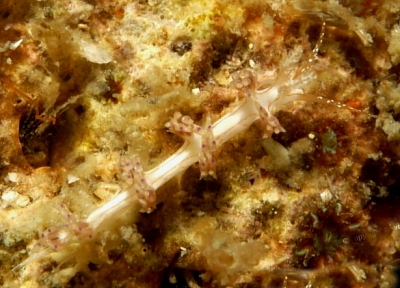
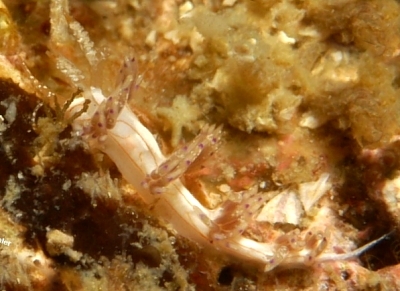
Concerning message #21974:
Dear Bill,
here is one more record of it from the Philippines
Locality: Malapascua Island, divesite: Gato Nudibranch City, 17 m, Philippines, West Pacific Ocean, 23 October 2005. Length: 17 mm
Erwin
Erwin@Philippine-Sea-Slugs.com
Koehler, E., 2008 (Oct 31) Re: Unknown Aeolid from Singapore. [Message in] Sea Slug Forum. Australian Museum, Sydney. Available from http://www.seaslugforum.net/find/22000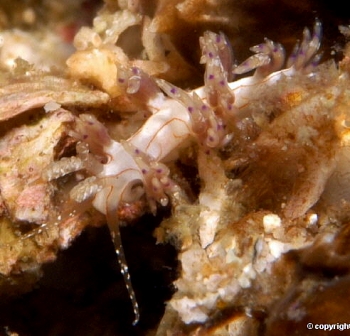
Thanks Erwin,
I suspect, from the general shape of the animal, that this is a species of Flabellina. Of course we would need to look inside to be sure, but I will risk it and call ths Flabellina sp. 9.
Best wishes,
Bill Rudman
Unknown Aeolid from Singapore
October 22, 2008
From: Toh Chay Hoon
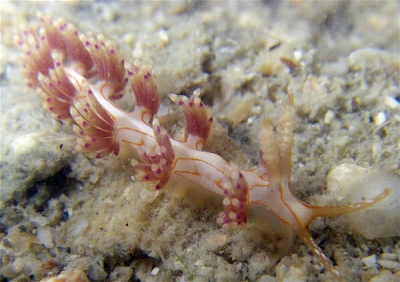
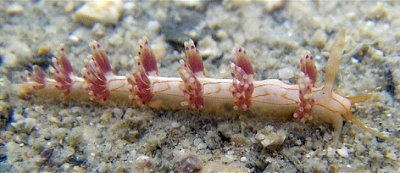
Dear Dr Bill,
I found this Aeolid nudibranch during an intertidal trip to one of Singapore southern island. It was found on Bryopsis algae.
I can't seen to find a match in the species list. Would you kindly shed some light?
Locality: Big Sisters Island, 0m, Singapore, South China Sea, 08 February 2008, Intertidal . Length: 15 mm. Photographer: Toh Chay Hoon.
Thank you.
Toh Chay Hoon.
sonnenflower@gmail.com
Toh C.H., 2008 (Oct 22) Unknown Aeolid from Singapore. [Message in] Sea Slug Forum. Australian Museum, Sydney. Available from http://www.seaslugforum.net/find/21974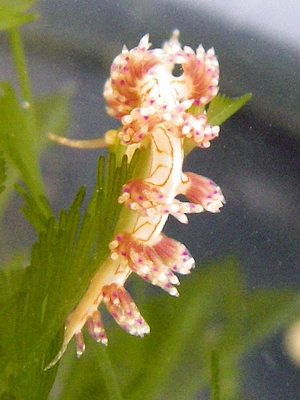
Dear Chay Hoon,
I feel I should recognise this species as it has quite distinctive features both in colour pattern and in the arrangement of the cerata. My best guess is that it is a species of Flabellina but until I know something about its internal anatomy, I can only make an informed guess. Hopefully someone will recognise it for us.
Best wishes,
Bill Rudman
